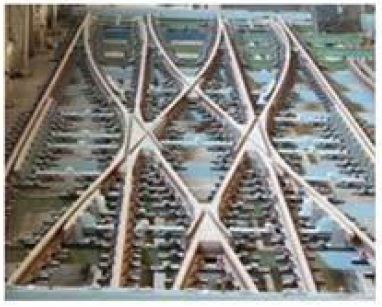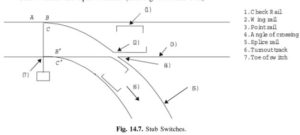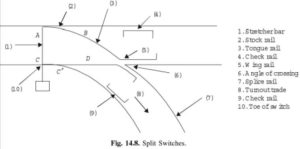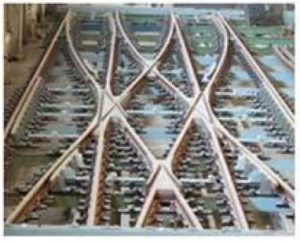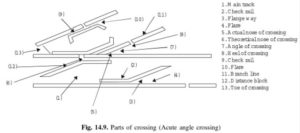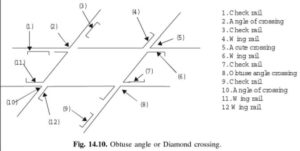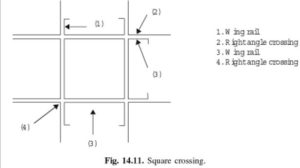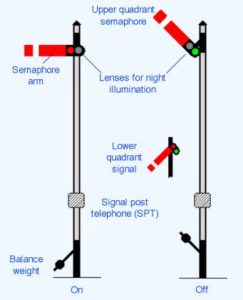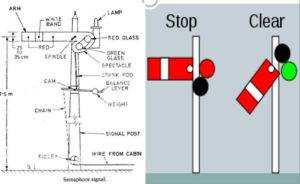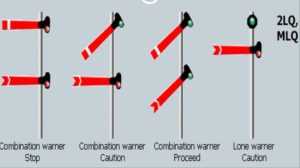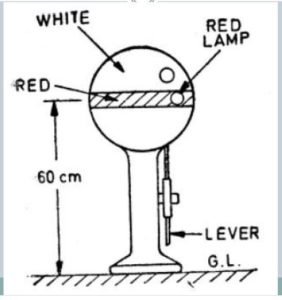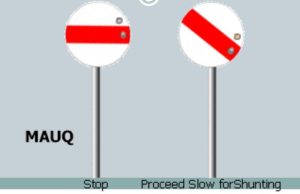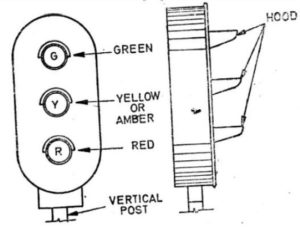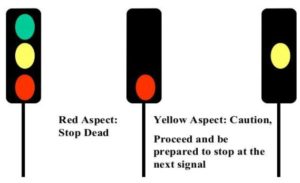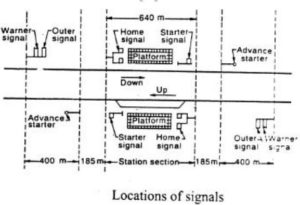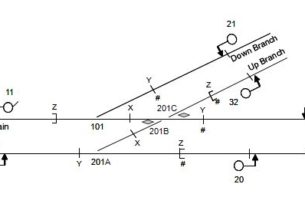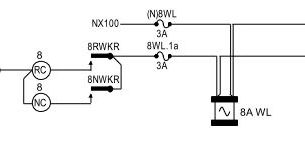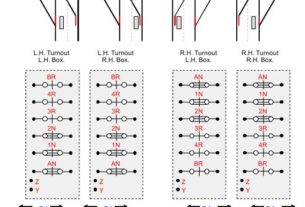Railway Switches Types
There are two types of switches
(i) Stub Switch
(ii) Split Switch
Stub Switch
1. Earliest type of switch. No separate tongue rails are provided
2. Some portion of the main tracks is moved from side to side
3. It is obsolete now and no more in use on Indian Railways
Split Switch
This the modern type of switch. It consists of a stock rail and a tongue rail.
Crossings
It is a device provided at the intersection of two tails to allow the trail moving along one of the tracks to pass across the other
Types of crossing
(i) Acute crossing or Ordinary crossing
(ii) Double or obtuse crossing
(iii) Square crossing
(i) Acute crossing or Ordinary crossing
1. Acute angle is formed when a right hand rail of one track crosses left hand rail of another track at an acute angle.
(ii) Double or obtuse crossing
1. This crossing is fixed when a track crosses another at an obtuse angle.
(iii) Square crossing
1. When one track crosses another track of the same or different gauge at right angle
SIGNALLING
General:
1. Railway signalling is a system used to control railway traffic safely, essentially to prevent trains from colliding
2. Signaling consists of the systems, device and means by which trains are operated efficiently and tracks are used to maximum extent, maintaining the safety of the passengers, the staff and the rolling stock.
3. It includes the use and working of signals, points, block instruments and other equipment.
Objects of Signaling:
1. To provide facilities for the efficient moving of trains.
2.To ensure safety between two or more trains which cross or approach each other’s path.
3. To provide facilities for the maximum utility of the track.
4. To provide facilities for safe and efficient shunting operations.
5. To guide the trains movement during maintenance and the repairs of the track.
6. To safeguard the trains at converging junctions and give directional indications of diverging junctions.
Types of Signal
1. According to function
2. According to location
3. Special signals
Classification according to function:
(a) Stop signals or semaphore type signals
(b) Warner signals
(c) Disc or ground signals
(d) Coloured light signals
(a) Stop signals or semaphore type signals
1. One of the earliest forms of fixed railway signal is the semaphore.
2. These signals display their different indications to train drivers by changing the angle of inclination of a pivoted ‘arm’
3. The stop position is the normal position and it is said to be ON position
4. The arm can be lowered at an angle of 40 0 to 60 0with horizontal and is said to be OFF position
The warner signal is similar to semaphore signal in shape except a v-notch at free end, ie. The movable arm is fish tailed as shown.
1. The white band is also of v-shape.
2. The warner signal is placed on the same post of the semaphore signal 1.8 to 2.1m below the semaphore signal.
3. The warner signal is painted yellow and exhibits yellow or amber colour at night instead of red colour.
(b)Warner signals:
Shunting Signals
1. These signals are used for shunting operations in station yards
2. They are of the shape of a circular disc with a red band on a white back ground
3. The disc can revolve in a vertical plane by pulling the lever by hand.
4. Two holes are provided, one for red lamp and the other for the green lamp.
5. When the red band is horizontal or shows red light at night it indicates ―STOP
6. When the red band is inclined at 45 degree or shown green light at night indicates ―PROCEED
Colour light signals:
1. Semaphore signals are being replaced by high intensity beam colour light signals both during day and night.
2. In case of colour light signals, the normal position is to indicate ―PROCEED (ie., shows green light).
3. When the section is blocked, it automatically indicates ―STOP‖ or ―DANGER (ie., shows red light).
4. In India these signals are used on urban and sub-urban sections with heavy traffic.
Colour light signals
Colour light signals
Locational characteristics
(i)Reception signals
(a)Outer signal
(b)Home signal
(ii) Departure signals
(a)Starter
(b)Advance Starter
Location of signals
(a) Outer signal
1. This is the first stop signal which indicates the entry of the train from block to the station yard.
2. It should be placed at an adequate distance (0.54km for BG and 0.4 km for MG).
3. It has one arm but may have a warner signal on the same post nearly 2m below it.
4. In the Stop position the driver must bring his train to a stop at a distance of about 90m before the outer signal and then proceed to the home signal with caution.
5. If it is in the Proceed position then the driver can take the train at speed assuming that home signal is also in the proceed position.
(b) Home signal
Due to its location at the door of station, it is termed as Home signal.
1. The home signal has bracketed arms to indicate which line is to be used.
2. The function of home signal is to protect the sidings already occupied.
3. It is located at not more than 180m from the start of points of switches.
4. Home signals carry as many arms as the number of diverging lines.
(c) Starter signals
1. It marks the limit up to which trains stopping at a station should come to a stand.
2. The starter is the last stop signal at a station.
3. It controls the movements of the trains when they depart from the stations.
4. No train can leave the station unless the starter signal shows the ―PROCEED position (ie., inclined position)
(d) Advance Starter signals
1. Besides the starter signal for each of the station lines from which trains starts, an advance starter may also be provided.
2. The advance starter becomes the last stop signal at the stations where is provided.
3. It is an indication for the train having left the station.
